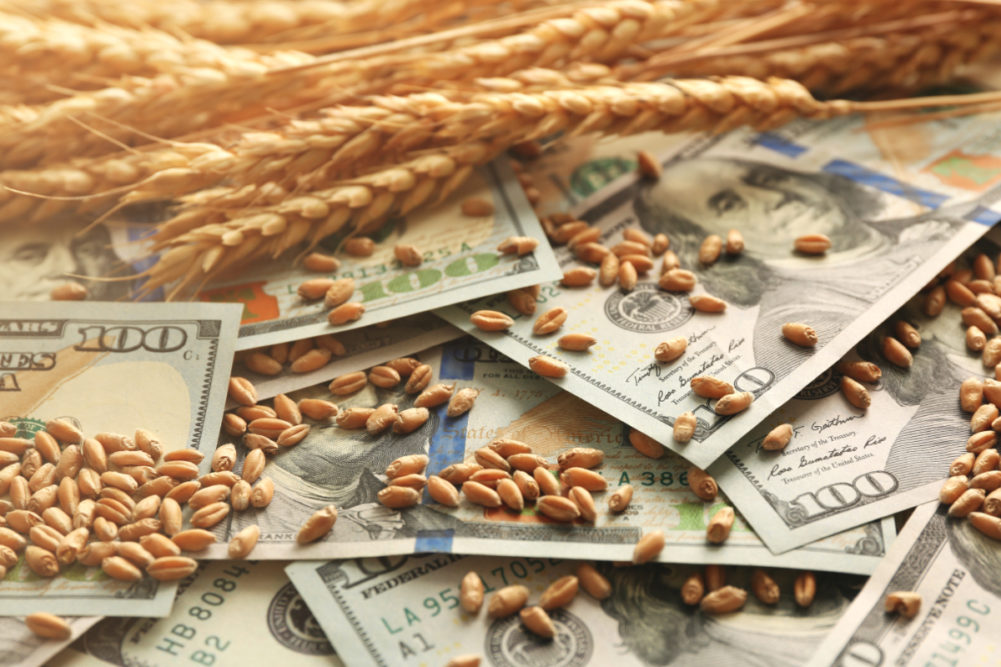KANSAS CITY, MISSOURI, US — With major grain, oilseed and edible oils prices at or near eight-year highs, crude oil prices six times the year-ago level, freight rates soaring and prices for materials (cardboard and aluminum, for example) and other input costs rising, can food price inflation be far behind? Not according to the US Department of Agriculture or many food manufacturing companies. If the expected post-pandemic demand surge develops, as many expect, price increases may be greater later this year and into 2022.
The USDA in late April forecast prices for all food in 2021 to rise 2% to 3% from 2020, when prices were up 3.4% from 2019. Prices in March 2021 in fact were up 3.5% from March 2020. The price of food away from home was forecast to rise 2.5% to 3.5% for the year, with the March figure up 3.7%. Food-at-home prices were forecast to rise 1% to 2% for the year, with March up 3.3%. The USDA classifies 45% of all food sales as away from home and 55% as at home.
Comparisons with a year ago are difficult because it was such an unusual year, including significant volatility in many commodity and ingredient prices and shifts in demand to retail from foodservice as travel slowed considerably and much of the country and world sheltered at home. But just as last year was unprecedented, most expect a demand surge this year as the country and world seek to resume some level of normalcy. Included in such a transition for many is expected to be the resumption of travel, meaning an increase in foodservice demand. Still, it is anticipated that at-home food demand will hold above pre-pandemic levels as a significant number of people continue to work from home.
“We continue to see signs of North America emerging stronger from the crises,” said Graeme David Pitkethly, chief financial officer at Unilever, in late April. “Demand for in-home foods remains high, and our out-of-home business is recovering faster than we expected.”
Several major food and beverage manufacturers issued “warnings” that price increases were on the way.
“We are hedging and forward-buying to cover some of this exposure, but it only delays the impact for a few months,” Francois-Xavier Roger, CFO of Nestle SA, said recently concerning price increases for such inputs as commodities, packaging material and transportation.
First-quarter (ended March 27) net income surged 49% from the same period a year earlier at Kraft Heinz Co., and the company faces rising input costs for the rest of the fiscal year that could lead to price increases for its products, executives said on a recent earnings call.
Mondelez International reported first-quarter (ended March 31) revenues up 4.3% from a year earlier, with sales growth for the year forecast at 3% or higher. Luca Zaramella, CFO of Mondelez, on a call with investment analysts said its growth guidance perhaps would be higher but for the volatile cost environment that includes surging ingredient prices.
Food manufacturers are working to mitigate the impact of rising input costs on their bottom lines.
“We expect the rate of inflation to continue to accelerate over the next few quarters,” said David S. Marberger, CFO of Conagra Brands Inc. “Fortunately, we have a variety of levers that can be used to offset this pressure, including pricing. We have already mobilized our inflation-justified plans with some actions already in market, others communicated to customers and some yet to come. History shows price adjustments are more likely to be accepted in the market when industrywide and broad-based input cost inflation occurs, and that’s the environment we see today.”
Hormel Foods Corp. has raised prices for Skippy peanut butter, Spam and the Jennie-O Turkey Store line, among others.
James N. Sheehan, CFO at Hormel, said the price of corn feed rose 40% during the first quarter, and soybean meal rose about 15%, prompting a change in the company’s turkey feeding formula to more soybean meal and less corn.
Many food and beverage manufacturers plan to raise prices.
James Quincey, chief executive officer of Coca-Cola Co., recently hinted at price increases in 2022 in an April interview on CNBC.
Meanwhile, in late April 2020 crude oil prices briefly crashed to multi-decade lows below $10 per barrel as fuel demand plummeted amid restricted travel due to the surging number of coronavirus cases worldwide. Recently prices have been trading over $60 per barrel. The US average on-highway price of diesel fuel last week was up 31% from a year earlier. Rising energy prices impact all levels of the food supply chain.




